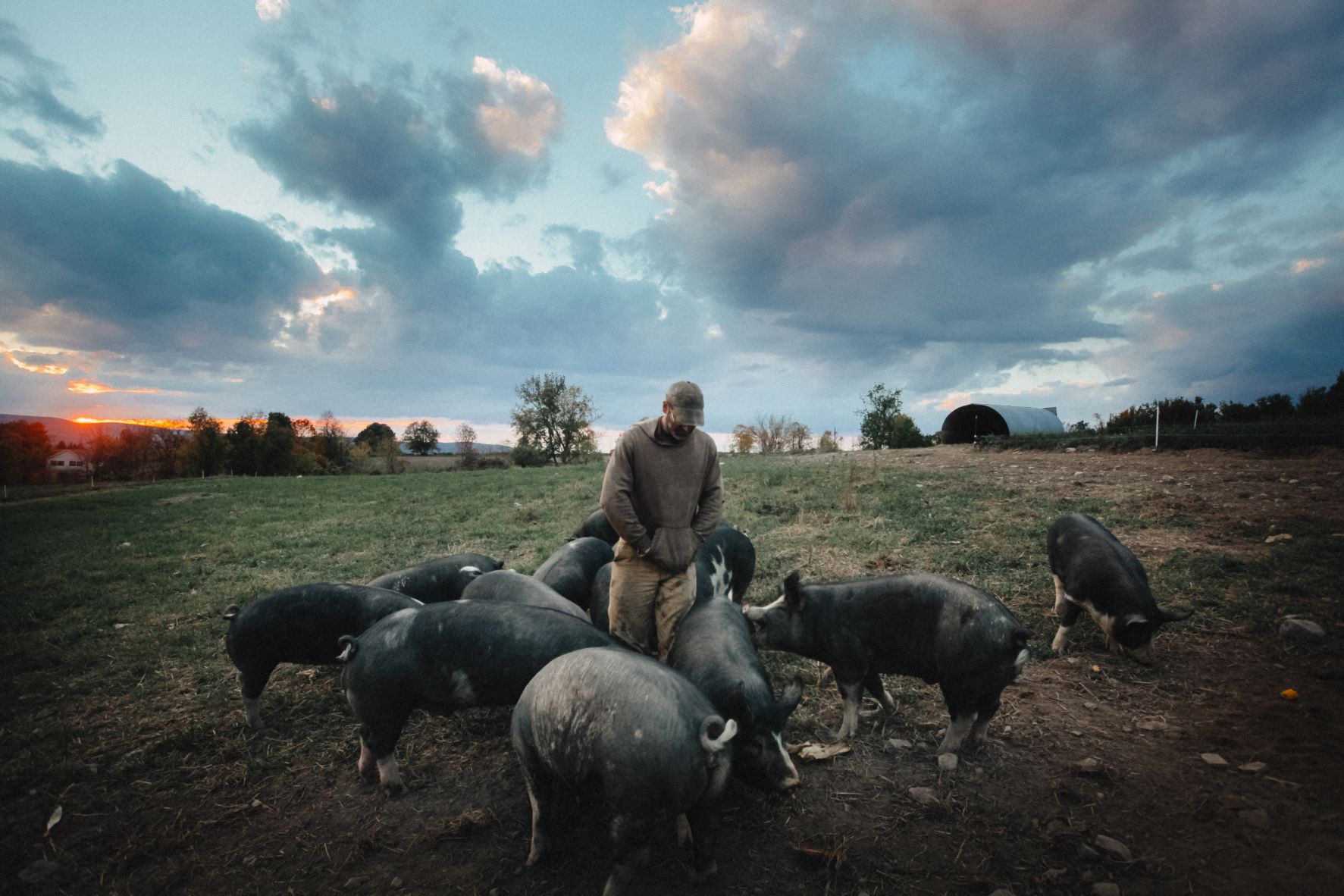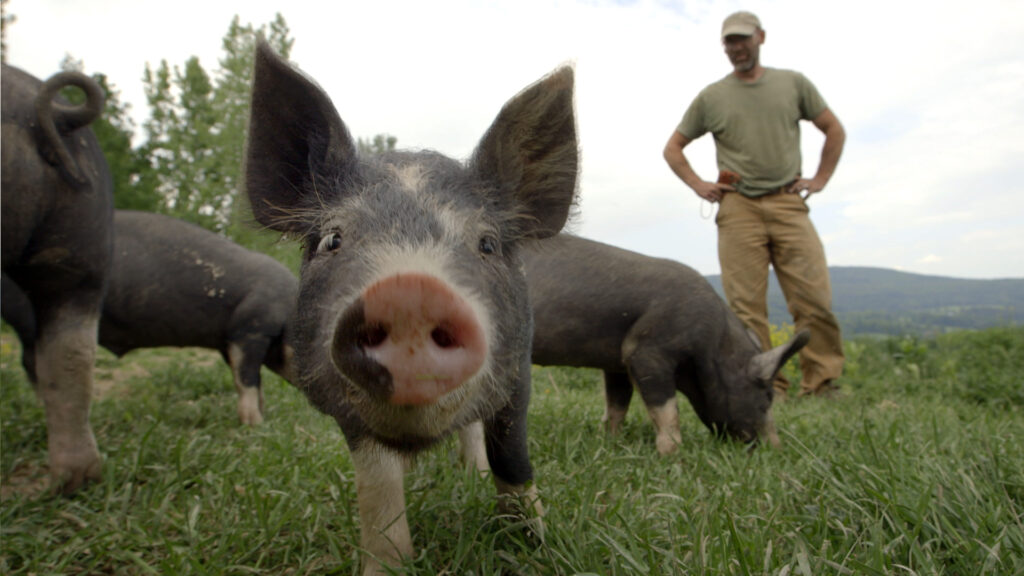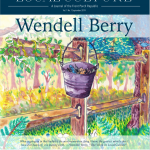Boise, ID. “I no longer want to peddle in death.” Those words from Bob Comis serve as a hinge in The Last Pig, a film which traces the conversion of Comis to vegetable-only farming. The last two decades have seen a spate of articles, books, films, and other media criticizing the industrialized food systems that feed most of America. Titles like Fast Food Nation, Food Inc., and The Omnivore’s Dilemma come quickly to mind. (Plus, plenty of ink has been spilled here at the Porch on such topics.) Often the heroes emerging in such stories are local/organic/grass-fed/holistic farmers like Joel Salatin. The Last Pig is a genre-busting film because farmers like Salatin and the pre-conversion Comis are implicitly painted as part of the problem rather than the solution. (To be clear, the film is presented as a purely personal journey. Neither Salatin nor any other farmer is mentioned by name.)
Set amid the rolling terrain of upstate New York, Comis’s acres bring to mind Salatin’s Polyface Farms in Virginia. Brooding Bob and boisterous Joel have very different public personalities, but both are sincere and thoughtful. Both men have built bucolic hog heavens on earth. Yet each has reached a very different conclusion about the work of pig farming.
Comis describes his youth as spent in a shopping mall “playing video games and eating fast food.” This unlikely farmer was once “extremely proud” of his efforts to provide others an alternative to industrialized pork, but he now finds the idea that “happy pigs make happy meat” to be “unsettling” and “disturbing.” Comis describes himself as “haunted by the ghosts of those happy pigs.”
By collaborating with talented filmmakers Allison Argo and Joseph Brunnette, it appears he wants us all to be haunted as well. This beautifully shot and sonically understated movie draws one into the inner-conflict that Comis experiences. It first made the film festival rounds in 2017, but it is again catching eyeballs and raising questions on PBS.
What do we owe animals? That seems the underlying inquiry. In a book and articles Salatin has emphasized the “marvelous pigness of pigs.” Much of The Last Pig focuses on a similar theme, highlighting the intelligence and social nature of the snouted ones. Comis describes pigs as “precious” and “sacred.” He notes, “After 10 years of looking into thousands of pig eyes, I’ve come to understand they’re never vacant. There’s always somebody looking back at me.”
The film shows Comis providing his pigs an undeniably good life, but seeing his pigs “so clearly full of joy” ultimately gave him “no sense of absolution.” What many would describe as a good death would come to the pigs at a small-scale processor where Bob knew the butcher by name. Do we, though, owe animals no death at all? And what becomes of them over the long-term if we take that view?
Several years back, I was asked to review a book where the vegan author was enthusiastic about the mass production of lab-created “meat.” This would save farm animals from death and maltreatment, but it would also prevent the possibility of full-bodied lives. Animal farms and ranches would be replaced by these protein “fabricators.” While I favored avoiding industrialized operations that treated hens as mere widgets, I questioned whether we really wanted egg-equivalents that, as their proponents boasted, would take “the chicken out of the equation” completely.
Comis could not financially provide a home for 200 pet pigs. That seems an apt metaphor for society writ large. If not raised for meat, most pigs will not be raised at all. Perhaps that is well and good. More habitat for wildlife may result, and a small remnant of pig breeds may endure as pets. Yet it is somewhat ironic that many of those who extol the virtues of pigs the loudest essentially advocate for removing most of their kind from the planet.
As the last of Bob’s pigs are either slaughtered or, for a hand-picked few, trucked off to one of the animal sanctuaries that helped to fund the film project, Comis describes an “emptiness” overtaking the farm. The main body of the film then ends with a drone shot of Comis walking in a snowy field, the camera pulling back until one sees only an all-encompassing white. Is this purity or nothingness?
For his part, Comis is shown in the film as having no regrets. While the transition to vegetables leaves him “terrified” of potential failure, he still affirms it as “the right thing to do.” Early in the film, Comis comments on how time with his livestock helped him to heal from depression. Nevertheless, “I would give up every single moment I spent with the pigs,” Comis says in the film’s epilogue, “just to bring one of them back.”
Do not count me among those tempted to dismiss Comis as overly dramatic. My infrequent episodes of bringing death to animals have always taken an emotional toll on me. Making a weekly trip to the slaughterhouse for over a decade, as Comis did, seems bound to leave a mark. Can such a wound be redeemed or is the purpose of this pain to dissuade us from the actions that bring it about?
Salatin sees his own encounters with the death of animals within a larger redemptive framework:
Sometimes we become so disconnected that we don’t have a frame of context for what true sacrifice is. Part of blessing our food is being grateful for the sacrifice whether it is a carrot, a pig, or a chicken. The ultimate purpose of living things is to give themselves for something else. The ultimate gift we can give is that we sacrifice in service for each other. And then there is the profound thought that there can be no eternal life without the sacrifice of Christ. There’s the ultimate example of life.
Salatin has worked for years now to spread the gospel of a multi-faceted farm far and wide through practice and pen. I have heard him describe himself as a “farmer who does some writing” in comparison to Wendell Berry whom he admiringly calls “a writer who does some farming.”
Over a decade ago, I met Wendell Berry for the first time. That encounter led to the reprinting of his essay “The Gift of Good Land” in the now-defunct journal Flourish. (Porchers might still enjoy flipping through its digital archives.) Berry’s trip through the Hebrew scriptures concludes with these words:
That is not to suggest that we can live harmlessly, or strictly at our own expense; we depend upon other creatures and survive by their deaths. To live, we must daily break the body and shed the blood of Creation. When we do this knowingly, lovingly, skillfully, reverently, it is a sacrament. When we do it ignorantly, greedily, clumsily, destructively, it is a desecration. In such desecration we condemn ourselves to spiritual and moral loneliness, and others to want.
Is that invocation of sacramental language appropriate or a cover-up for crimes against animals? Berry, in his poem “For the Hog Killing,” does not gloss over the violence involved:
Let them stand still for the bullet, and stare the shooter in the eye, let them die while the sound of the shot is in the air, let them die as they fall, let the jugular blood spring hot to the knife, let its freshet be full, let this day begin again the change of hogs into people, not the other way around, for today we celebrate again our lives’ wedding with the world, for by our hunger, by this provisioning, we renew the bond.
Comis opens The Last Pig speaking of the connection between a farmer and his pigs. “They follow me— curious, interested, and irresistibly gregarious.” But he laments, “They don’t know that this communion is a lie.” Is it a lie or a hard truth in a fallen world? Can one pull the trigger not in sin but in thankfulness for a life well-lived—a life whose death will sustain the lives of others?
I am still inclined to side with Salatin and Berry, but the story of Bob Comis should be in the conversation too. In a culture where the blood of animals is shed far too inhumanely, the story of one man walking away from even the best of the available scenarios deserves a hearing. We ask much of our farmers and butchers, those who deal out death for us. They deserve our respect and compassion if ever they decide to put the knife away.
We ask much of our fellow creatures as well. They deserve our compassion. Even if we struggle to define exactly what that looks like, most of know what it is not. Yet, I am among those who too often succumb to the temptations of avoidance that the ease that our dominant food culture provides. In their own ways, Salatin, Berry, and Comis all challenge us to look our food in the eye.








11 comments
Ray Stevens
I am old now. When I was young I hunted and fished and ate what I got. I worked on a farm with pigs and turkeys to pay for college. I worked in an abatoir (sp?) when the pigs were killed. I live in the country and have raised and killed pigs, goats, sheep, chickens and rabbits. I can no longer do it. They know when you come to kill them! I don’t know what they know or how they know it, but they all know that is why you are there this time. It haunts me to think of ever doing it again.
How then will we feed the multitude?
Kevin Hadley
This topic always makes me think of the James Dickey poem, “The Heaven of Animals.” My heaven happens to include bacon.
I struggle to see death as “the last enemy,” because it’s hard to imagine life without death. But there’s a truth in there that folks like this ex-pig-farmer see that maybe we don’t.
Clark
In our fallen world, and given the hard nature of the sacrificial gift of our Savior including the Gethsemane that comes before, I can understand how one might find that they could no longer maintain this particular priesthood however lovingly constructed the liturgy might be. Thanks for the reminder of the Gift of Good Land and to pray for those who preside there over the life and death and sacrifice that feeds us.
martin
Thanks, Brian. Not only the culture. Ever since the invention of muskets (not counting catapults and other siege weapons aimed at walls), the distance between killer and killed has increased, thereby masking our inherent aversion to eliminating a fellow being that God has granted life to.
martin
I forgot about the bow and arrow, blow gun, etc.
Martin
This is an excellent article that goes directly to the key point of whether nurturing is a form of betrayal, then explores various aspects. About 30 years ago, it occurred to me that it was a form of betrayal, so I ate only “wild” meat for a few years (e.g., ocean fish, though some of those are now “farmed” in enclosed areas).
Assuming Brian M’s stats about soldiers recruited from farms (an ancient practice that partially explains why many pre-modern wars were fought during months other than growing/harvest) are accurate, his argument strongly counters David N’s admittedly cynical attempt to reduce humane killing to a recent fetish.
However, I think David does hint at the conflation of keeping food animals and caring for pets, which John mentioned in passing. The fact that we can recognize vertebrates as having a form of consciousness (or embodying part of a universal spirit) doesn’t mean we actually know what they feel.
We know when we are raising animals humanely, and we can see that they instinctively avoid dying, but we really don’t know “what they want out of life”.
I’m reminded of a dog we raised from birth who ran off at age 3. We thought he was living an optimal life: well-fed, loved by our family, spacious yard, often let off the leash in a field, befriended other dogs in the neighborhood. But maybe he didn’t feel it was optimal and he was free enough to seek something else?
Brian D Miller
Martin,
The book I pulled that info from was, On Killing: The Psychological Cost of Learning to Kill in War and Society by Lt. Col. Dave Grossman. He was the psychologist at West Point. The book came out in the 90’s, when I read it. So, admittedly, I’ve slept since then, but looking over the summary on Google this morning, it seems largely as I remember. Although he doesn’t explicitly make the case that it was the farming exposure to life and death that caused that reluctance to kill. That connection is based more of my own reading into his work. One might also infer other cultural shifts as well from the data. But the core data is based on the military keeping very careful records for a long time. They worked hard to develop techniques to break down that reluctance as quickly as possible. Fortunately for them, the culture caught up with them.
Eric K.
Thanks for posting this. It’s thoughtful and worth considering. I remember reading The Omnivore’s Dilemma, in which Pollen makes a similar point talking about chickens: without being consumed by humans (or at least their eggs) they’d cease to exist. How long would chickens last in the wild without our protection? He writes that they have adapted over the millennia to abide with humans for the survival of their species.
David Naas
As one whose college education was facilitated by the pigs my Father raised for auction, who did not truly comprehend the price of pork (as we butchered twice a year) until I had to PAY for a cut of ham, my sympathies are not with those of a delicate conscience.
My parents lived through the Great Depression, on farms to be sure, but were still acquainted with the very real idea of hunger and insufficient resources to get by. This modernist “conscience” is more the product of an overfed middle class which has lost it’s place in the universe, especially it’s roots in humanity, with the problems of others less fortunate, and lives in an artificial world of theoretical fancifulness. Even those who presume to be Gentleman Farmers.
What is not said is the incredible amount of waste inherent to the modern systems of meat production/consumption. Therein lies the real sin, if there be one. Order a fast food hamburger meal and you get 3000 empty calories, unless you discard half of it as many do.
I was raised by the aforementioned Depression parents, not to waste a scrap of food, “because”. Because you never know when you might see another, because you might run out before next harvest, because some other person might be hungry and you can feed them… ah. There’s the rub.
It is not the eating of meat, but the hunger of humans about the world, about the nation, about your neighborhood, which is the problem. And all those obese people you see at Walmart, are they “well-fed”. It is to laugh. Or cry.
Middle-class angst is interesting, but not really pertinent. Perhaps my Lower-class callousness is not either. But the machine has efficiently insulated the Middle-class from reality as to make me wonder how they will fare when the next major social crisis hits the world.
Garth Brown
Thanks for this article, John.
I think you’ve put your finger on the fundamental point; how can we farmers (or eaters who have a realistic idea of what raising livestock entails) strive to provide the creatures in our care with a high quality of life, yet go on to kill them? There is an undeniable contradiction, or at least a very real tension, in keeping one eye on the wellbeing of a pig and the other on the smokehouse.
But the contradiction offered by the alternative is even more jarring. Yes, it is sadder to kill a pig than it is to uproot a head of lettuce, but that’s precisely because a pig adds more to the world. How is getting rid of them entirely the better choice? As I wrote in FPR a few years back, “it is an odd plot that would save cows by precipitating their extinction.”
It seems to me there is a repudiation of existence built into this view, something quite similar to the anti-natalist argument when it comes to having children. I’ve given up on arriving at a series of logical propositions capable of satisfactorily repudiating this view, since there is an element of faith in believing that participating in existence is preferable to not, even when – especially when – it always comes with some degree of suffering.
Anyhow, thanks again for the thoughtful piece.
Brian D Miller
I like this linking, John, between giving thanks and the slaughter, not that the latter means much to the slaughtered. It is also one of the reasons why for 22 years we have not sold cuts of meat. When you buy pork, lamb, chicken, or beef from our farm you buy a whole, side, or, in the case of beef, a quarter of the animal. That commitment to the whole animal, that way of eating, does more honor to that act of slaughter.
There is a tension, always, between the raising and nurturing, and the fattening and the killing. One in which on a small farm we are right up and personal with all the time.
It is problematic though to see farming, and indeed diet choices, as a one size fits all. Not all land supports extensive arable farming, not all “fossil” groundwater deserves to be used up to grow strawberries in January to be trucked to Boise (which I know you are not asking for). Which means, at least the way I see it, there is room for the small diverse farm.
I have found that the act of butchery has made me more compassionate, not less. It is for the same reason the US military struggled with WW1 and WW2 to soldiers to get them to aim to kill another person. Fully 90% misaimed their rifles when presented a human like target. That most of those men came from farms or had links with a farming background has been noted. And current studies show that 90% of new recruits have no problems with aiming to kill another human. “Food” for thought.
Ultimately it is good to be conflicted about the killing. It is good to know and visit the source of your meat, vegetables, and fruit. It is good to eat seasonally. And it is essential that, if eating meat, you eat nose to tail. Oppose the industrial machine in all forms, embrace the small and the local, and give thanks for your meal.
Comments are closed.